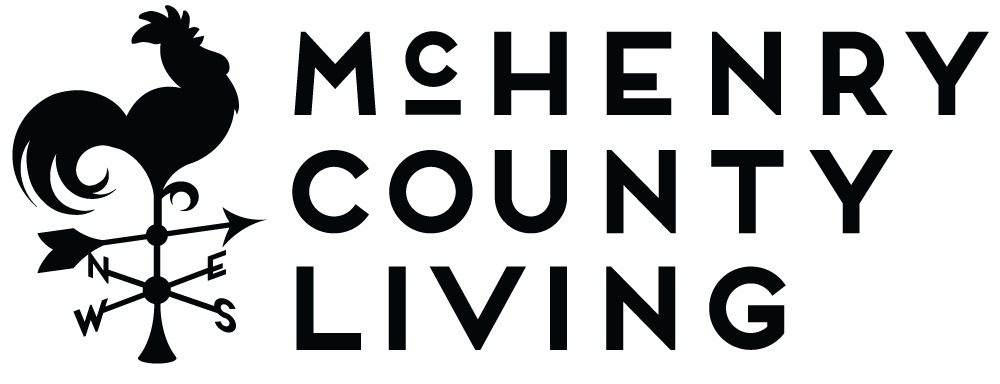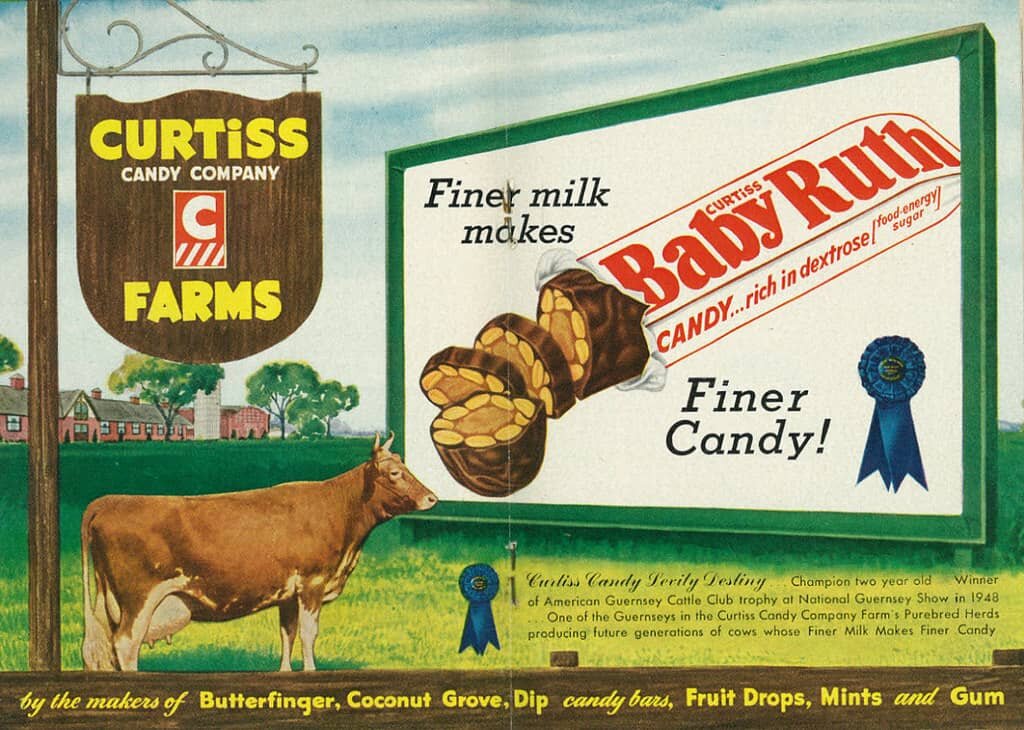Baby Ruths, Butterfingers & Stud Bulls
The story of Trout Valley’s own “Candy Bar King” turned pioneer bull breeder.
by the Cary-Grove Historical Society
Did you know that Cary, Illinois, was once the cattle-breeding capital of the United States? It may further surprise you to learn that this lofty place in the nation’s pastoral landscape owed its existence to one man’s boyhood dreams and a financial empire built on candy bars.
McHenry County’s most celebrated farm in the 1940s and 50s was indeed built on Baby Ruths and Butterfingers. A man named Otto Schnering, the “U.S. Candy Bar King,” brought that fame to Cary when it was still a rural town of fewer than 1,000 residents. Sales of his Curtiss Candy Co.’s signature snacks had topped $1 million per week, and Schnering parlayed that fortune into a farming enterprise based in southeastern McHenry County that changed the cattle-breeding industry forever.
A SELF-MADE CANDY BAR KING …
The Curtiss Candy Co. was founded by Schnering in 1916. He used his mother’s maiden name rather than his own, either in tribute to her, or owing to the unpopularity of German surnames at the time. A 24-year-old University of Chicago graduate, Schnering cooked up his recipe for nickel candy bars with a 5-gallon kettle in the backroom of a north-side hardware store he rented as company headquarters.
He introduced Baby Ruth to the market in 1921. It is unknown whether the candy bar was named for the first-born daughter of President Grover Cleveland or for the slugger of New York Yankees fame. All the same, so confident was Schnering in this chocolate-covered caramel and peanut treat that he offered the first box of 12 to retailers for free. At five cents each, they sold out fast. The popular Butterfinger and Polar Bear candy bars soon followed, and Otto Schnering was well on his way to becoming a millionaire.
MOVES TO MCHENRY COUNTY …
Yet Schnering’s work was not done yet. He’d always wanted to be a farmer. A love for animals was born in him as a child while raising pigeons in the basement of his family’s Chicago home. Spending summers as a boy at his father’s Michigan farm had instilled in Schnering a taste for country living. So, when told by doctors to, “Take things easy,” in the early 1940s, perhaps it was with these childhood memories in mind that the big-city entrepreneur began buying up Midwestern farmland.
He also had a business motivation. The Curtiss Candy Co. was buying millions of pounds of milk, butter and eggs per year. Schnering simply wanted to show his current suppliers how a quality farming operation was really run.
In 1944, he purchased the horse-breeding estate of John D. Hertz, of rental car fame, in the rolling green hills of the Fox River Valley. It became his primary residence. Schnering planted nearly 3,000 bushes and trees on this already picturesque location in Cary and named it “Curtiss Farm 711.” 711 was a lucky number; Mrs. Schnering even had it on her license plate. Here he fulfilled his childhood dreams by creating a showplace farm to be lauded by agricultural aristocrats nationwide.
Hertz’s original structures, some of which had hosted fancy parties attended by the likes of Eleanor Roosevelt, Will Rogers and Amelia Earhart, were converted into housing for farm animals.
AND BUILDS A BETTER BARN …
Schnering oversaw a truly impressive operation in what is today the Village of Trout Valley and the Brigadoon subdivision in Cary. By 1949, the 900-acre Curtiss Farm 711 had 900 dairy cows, 9,000 hens that produced 2.5 million eggs annually, 8,000 turkeys, 6,000 hogs, plus chickens and ducks; mink were brought in to feed off the chicken waste, along with sheep, ponies and beef cattle. The property also featured naturally flowing springs. He capitalized off these springs by building a quarter-mile-long hatchery, eventually selling up to 100,000 trout to Chicago hotels and restaurants annually. (Hence, the name Trout Valley.)
“Every cow on this farm is a lady,” Schnering was fond of saying, “and should be treated as such.” A stanch believer in cleanliness, he kept his cow barn in Cary as sanitary as his candy factory in Chicago. It boasted air conditioning, a bovine maternity ward and electronically-charged fly screens. The calf mortality rate there approached zero, while the nationwide average ran upwards of 25 percent at most other farms.
Schnering’s true pride, however, was his collection of prized bulls. “Except for television,” he said, “artificial breeding is the fastest growing business in the U.S.” And so, the Curtiss Breeding Services was conceived. These purebreds sired thousands each through artificial insemination. Their pedigree was the best money could buy. Schnering’s favorite was Swanky Dan, valued at $1 million, a bull he personally tended to in its final moments of life. One Curtiss stud, named Astronaut, was later proclaimed in newspapers across the nation as the, “biggest daddy of them all,” owing to its nearly 40,000 offspring over 12 years.
As a result of this innovative breeding program, Schnering’s cattle won 500 championship trophies and 1,200 blue ribbons at competitions across the globe.
Otto Schnering, Dorothy Schnering, and Barbara McFarland (Schnering grand-daughter) at Curtiss Farm terrace, 1951.
… FOR “ALL OF US”
Schnering was good to his employees, too. At its peak, Curtiss Farm 711 employed approximately 100 workers, many of whom lived on the farm or in Cary residences owned by Schnering. Single men lived in the bachelors’ apartment. Families received farm housing, and children were provided free weekly horse riding and swimming lessons among the endless opportunities for outdoor fun and frolic. There were even honeymoon suites for newlyweds.
The massive stone entry gates to Curtiss Farm 711 were always opened wide for visitors. Thousands came every year to view the well-groomed farm, apt to be greeted at any turn by Mr. and Mrs. Schnering in person. Some locals might remember the popular six-hitch pony carts that conveyed visitors around the farm site.
Otto Schnering died in 1953. The Curtiss Candy Board of Directors sold most of the agricultural holdings to a housing developer, yet the breeding service remained under the control of his widow, Dorothy, and continued on for several years.
“All of Us” was Otto’s motto, and he embraced the entire Curtiss Farm community as part of his extended family. He often sponsored parades, in an era when one could still witness a massive bull pulling a cart down Main Street. Schnering gave generously as a philanthropist, too, supporting boys and girls clubs and providing fundraising opportunities to church groups and civic organizations. One of his largest bequests was the complex that currently houses the Cary Village Hall and Cary Police Department. Inside, one can see an impressive display of trophies, ribbons and championship certificates awarded to Schnering’s prized bulls back in the heyday of Curtiss Farm 711.
“Otto Schnering made a tremendous impact on this area,” said Trout Valley historian Bob Baker. “Many residents either worked at or derived work from his estate. It is a shame that this significant part of local history has been nearly forgotten.”



